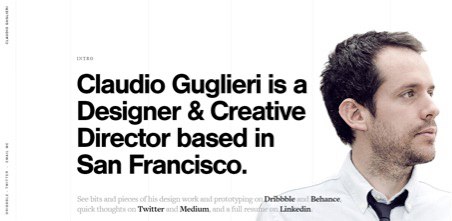More and more designers are using online publishing platforms to build their personal websites. It’s easy, it’s fast, it requires zero coding skills and the opportunities are limitless – one could not believe what these platforms have to offer today. We’ve selected 6 brilliant portfolios made with online-platform to show you how to make your own portfolio truly remarkable.
Mikha Makhoul

Fields — Digital design
Location — Cologne, Germany
Mikha Makhoul designed several media installations for both Gap and Mango stores, and created gamification and digital storytelling campaigns for Pull&Bear and Grand Cinemas. His portfolio was recognized by the pioneers of web achievements – Awwwards. Makhoul’s website consists of three parts: About, Work, and Contact. The structure may seem a bit too minimalistic at first, but do you really need more than that to present your professional skills? One of the most important rules for creating an online portfolio — don’t overdo it. Mikha Makhoul shows how to keep it simple with sleek images accompanied by brief project descriptions.
Rich Brown

Fields — UX/UI design, Digital design, Brand design, Photography
Location — Norwich, United Kingdom
Freelance designer, photographer and also an Awwwards nominee Rich Brown decided to open his portfolio with the animation of his own face – a direct and powerful way to say “Hi, this is me and this is what I do”. Contrasting typography adds to the beautiful imagery. Another rule of a great web portfolio is to use consistent navigation. Brown made it happen with a plain menu fixed in the upper right corner. This simple yet elegant navigating element carries the viewer to the main page or any project in the portfolio.
Natalie Bokhonko

Fields — UX/UI design
Location — Lviv, Ukraine
Ukraine-born Natalie Bokhonko currently works as a product designer for a software development company in San Francisco. When we open the main page once again we see the designer herself. This is not a portfolio “must-have”, but it immediately forms a solid personal space and adds character to it. Even though Natalie chose to present only 4 projects (and that is the next rule — choose quality over quantity), she provided extremely detailed information about each one of them: font guidelines, color palettes, a list of both UI and UX elements and descriptions of her design process.
Claudio Guglieri

https://guglieri.com
Fields — Web design, Digital design
Location — San Francisco, USA
Claudio Guglieri is the former design director of the human-centered design agency Fantasy. He now freelances for companies all over the world and travels with lectures. He manages to keep the portfolio constantly updated, which is the fourth rule. Starting with the links to the events he is participating in, to his newest works. Each project in the portfolio has only one scrolling image with a link, that takes us to the page with the whole case study. As a result, Claudio Guglieri has the ability to update his online portfolio without spending an excessive amount of time or radically changing the layout.
Anton&Irene

Fields — Product design, Digital design, UX design, Photography, Video
Location — New York, USA
Anton and Irene call themselves «former Manhattan agency directors turned Brooklyn hands-on designers». They’ve created an outstanding, colorful and a very cheery portfolio. On the main page you can see a mandatory portrait (seriously, insert a couple of headshots into your portfolio right away) – the designers are wearing bright and colorful gowns and start moving as you scroll down. They managed to seamlessly integrate several projects made with Readymag into their custom-built website. This enabled Anton&Irene to create a unique layout for presenting each project without hiring a development team. While browsing their website, you are technically jumping from one platform to another without even realizing it. Readymag is not an open source, but the designers state that the Readymag team «was kind enough to embed our custom code into their account that would show our global navigation on top of the case studies which would be living on the Readymag platform». And this is another rule — find your own way to stand out.
Nicolas Paries

Fields — Interactive Design
Location — Paris, France
French freelancer Nicolas Paries is the first one in our selection without a main page photo (yet a tiny GIF with his face could be found in the more traditional About section). Instead of the popular portrait the designer inserted an audio widget, another fun thing Readymag allows you to do. Each project has its own music track. This portfolio was made with a basic template and consists of 11 slides altogether. Paries balances the simplicity of the structure with many graphic gimmicks, illustrations and original backgrounds. Each project is presented as a vertical sheet, designed in it’s own unique way. This is another example of a portfolio which didn’t take a lot of time to make but nevertheless becomes a vivid and memorable experience as you scroll through. And here comes the most important rule: to create a great portfolio sometimes you have to break the rules.






Leave a Reply